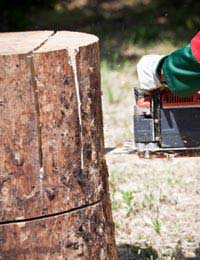
Now any article that tells you how to do something that can be very dangerous is bound to start with a serious health warning, right? And this article is no different.
Health and Safety Warning
No one can learn to fell a tree by reading an article and the intentions here is only to give a flavour of what’s involved. You can then make an informed decision – can you learn enough to fell trees yourself or should you get a tree surgeon in?
If you decide to go it alone then it is up to you to research the tree you are felling and learn all the techniques and safety practices yourself. Go on a course to learn how to fell trees properly. If you are in any doubt whatsoever then defer to a tree surgeon. Safety is of paramount importance when felling trees and the correct safety gear for the tools you are using should be worn at all times.
Only Tackle What You Can Cope With
Assess the job first. This article will cover the felling of a small tree that can be cut down in one go. If the tree is larger and there isn’t the room for it to fall, this technique will not work.
You will have to get a tree surgeon in to climb the tree, with the correct ropes and harnesses, and lop branches off before cutting the trunk down in sections from the top. This is not a job for an amateur and it is not covered here, you should hire a tree surgeon instead.
Start at the Bottom
Firstly clear the area around the tree as best you can. The tree will need space to fall but, more importantly, you need space to run away if necessary. Cut off all the lower branches you can reach, with a chainsaw or hand saw. Then cut the buttresses away, the triangular tops of the roots that stick out above ground on some trees. You can leave a buttress at the back to provide support while you make the other cuts.
The first cut isn’t the one that fells the tree but the one that creates the space on the other side of the cut for the trunk to fold over. Cut out a wedge by making a forty-five degree cut downwards into the trunk and then a horizontal cut that meets it.
The wedge should go about 45% of the way into the trunk. The position of the wedge will dictate the direction in which the trunk falls so make sure it is aligned properly. You can make the cut with a hand saw but a chainsaw makes it a lot easier.
Felling Cut
Now move round to the back to make the felling cut. This is just one cut, made slightly above the bottom of the wedge you just cut out of the other side. Make sure you stand to the side of the tree and get ready to move away. This is one cut where a chainsaw has a big advantage of a hand saw because of its speed.
Cut in about 45% of the width of the trunk again. You should be left with a small strip of timber in the middle that’s about a tenth of the width of the trunk. This acts as a hinge over which the tree will fold.
The Fall
Before you reach that point the tree should have started to fall, so whip the chainsaw out and stand back, moving away from the tree to the left or right, not directly behind it (or in front!). If it doesn’t fall, don’t be tempted to cut away more of the hinge. What can happen then is that the hinge breaks and the trunk kicks out in an unpredictable direction.
Leave the cut as it is and start widening the felling cut with a wedge. Insert it into the felling cut and whack it in with a sledge hammer until the tree finally falls safely over in the direction you first intended. Then watch your tree slow fall exactly where you told it to.




Leave A Comment